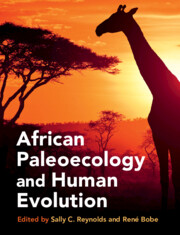40 results
Appendix B: - Fossil Sedge Culm-Species X, Interpretation of Culm Tissue Anatomy
- from 33 - Lower Bed II Olduvai Basin, Tanzania: Wetland Sedge Taphonomy, Seasonal Pasture, and Implications for Hominin Scavenging
-
- Book:
- African Paleoecology and Human Evolution
- Published online:
- 19 May 2022
- Print publication:
- 09 June 2022, pp 433-434
-
- Chapter
- Export citation
Volume References
-
- Book:
- African Paleoecology and Human Evolution
- Published online:
- 19 May 2022
- Print publication:
- 09 June 2022, pp 492-575
-
- Chapter
- Export citation
Contents
-
- Book:
- African Paleoecology and Human Evolution
- Published online:
- 19 May 2022
- Print publication:
- 09 June 2022, pp vii-viii
-
- Chapter
- Export citation
Appendix A: - Extant Sedge Cyperus fastigiatus Culm Tissue Anatomy
- from 33 - Lower Bed II Olduvai Basin, Tanzania: Wetland Sedge Taphonomy, Seasonal Pasture, and Implications for Hominin Scavenging
-
- Book:
- African Paleoecology and Human Evolution
- Published online:
- 19 May 2022
- Print publication:
- 09 June 2022, pp 431-432
-
- Chapter
- Export citation
PartI - Modern Africa and Overview of Late Cenozoic Paleoenvironments
-
- Book:
- African Paleoecology and Human Evolution
- Published online:
- 19 May 2022
- Print publication:
- 09 June 2022, pp 1-48
-
- Chapter
- Export citation
6 - The Southern African Sites
- from Part II - Southern Africa
-
-
- Book:
- African Paleoecology and Human Evolution
- Published online:
- 19 May 2022
- Print publication:
- 09 June 2022, pp 49-65
-
- Chapter
- Export citation
Part II - Southern Africa
-
- Book:
- African Paleoecology and Human Evolution
- Published online:
- 19 May 2022
- Print publication:
- 09 June 2022, pp 49-160
-
- Chapter
- Export citation
Part IV - Northern Africa
-
- Book:
- African Paleoecology and Human Evolution
- Published online:
- 19 May 2022
- Print publication:
- 09 June 2022, pp 461-491
-
- Chapter
- Export citation
Copyright page
-
- Book:
- African Paleoecology and Human Evolution
- Published online:
- 19 May 2022
- Print publication:
- 09 June 2022, pp iv-iv
-
- Chapter
- Export citation
Dedication
-
- Book:
- African Paleoecology and Human Evolution
- Published online:
- 19 May 2022
- Print publication:
- 09 June 2022, pp v-vi
-
- Chapter
- Export citation
PartIII - Eastern and Central Africa
-
- Book:
- African Paleoecology and Human Evolution
- Published online:
- 19 May 2022
- Print publication:
- 09 June 2022, pp 161-460
-
- Chapter
- Export citation
1 - Introduction: African Paleoecology and Human Evolution
- from Part I - Modern Africa and Overview of Late Cenozoic Paleoenvironments
-
-
- Book:
- African Paleoecology and Human Evolution
- Published online:
- 19 May 2022
- Print publication:
- 09 June 2022, pp 1-6
-
- Chapter
- Export citation
10 - The Paleoenvironments of Sterkfontein
- from Part II - Southern Africa
-
-
- Book:
- African Paleoecology and Human Evolution
- Published online:
- 19 May 2022
- Print publication:
- 09 June 2022, pp 92-101
-
- Chapter
- Export citation
Acknowledgments
-
- Book:
- African Paleoecology and Human Evolution
- Published online:
- 19 May 2022
- Print publication:
- 09 June 2022, pp xiii-xiv
-
- Chapter
- Export citation
Plate Section (PDF Only)
-
- Book:
- African Paleoecology and Human Evolution
- Published online:
- 19 May 2022
- Print publication:
- 09 June 2022, pp 583-598
-
- Chapter
- Export citation
2 - Approaches to the Study of Past Environments
- from Part I - Modern Africa and Overview of Late Cenozoic Paleoenvironments
-
-
- Book:
- African Paleoecology and Human Evolution
- Published online:
- 19 May 2022
- Print publication:
- 09 June 2022, pp 7-14
-
- Chapter
- Export citation
15 - Hominid Paleoenvironments in Tropical Africa from the Late Miocene to the Early Pleistocene
- from Part III - Eastern and Central Africa
-
-
- Book:
- African Paleoecology and Human Evolution
- Published online:
- 19 May 2022
- Print publication:
- 09 June 2022, pp 161-186
-
- Chapter
- Export citation
Index
-
- Book:
- African Paleoecology and Human Evolution
- Published online:
- 19 May 2022
- Print publication:
- 09 June 2022, pp 576-582
-
- Chapter
- Export citation
Contributors
-
- Book:
- African Paleoecology and Human Evolution
- Published online:
- 19 May 2022
- Print publication:
- 09 June 2022, pp ix-xii
-
- Chapter
- Export citation

African Paleoecology and Human Evolution
-
- Published online:
- 19 May 2022
- Print publication:
- 09 June 2022



